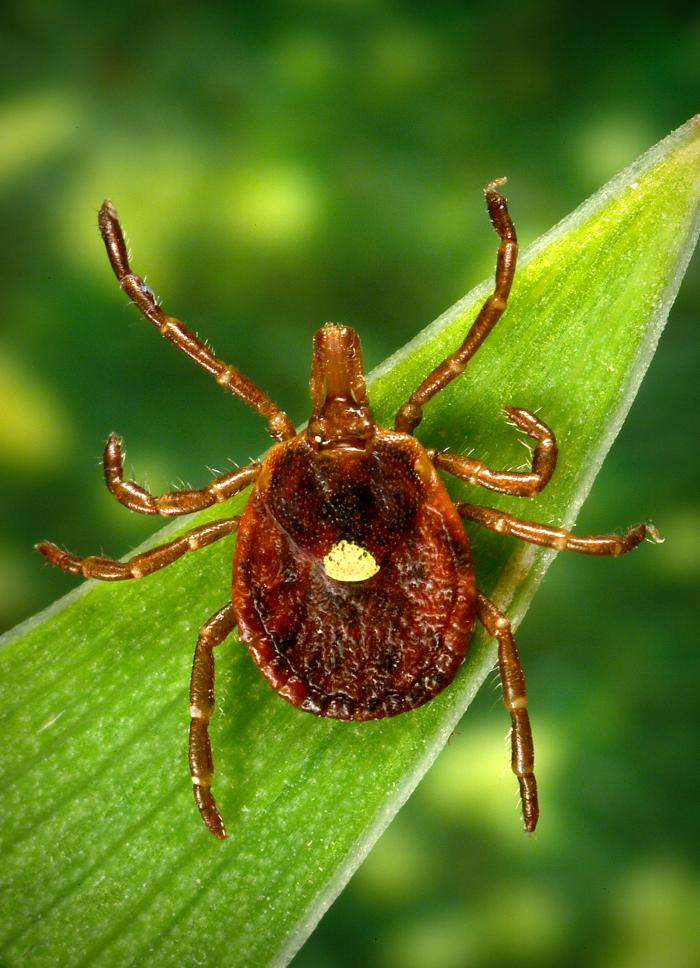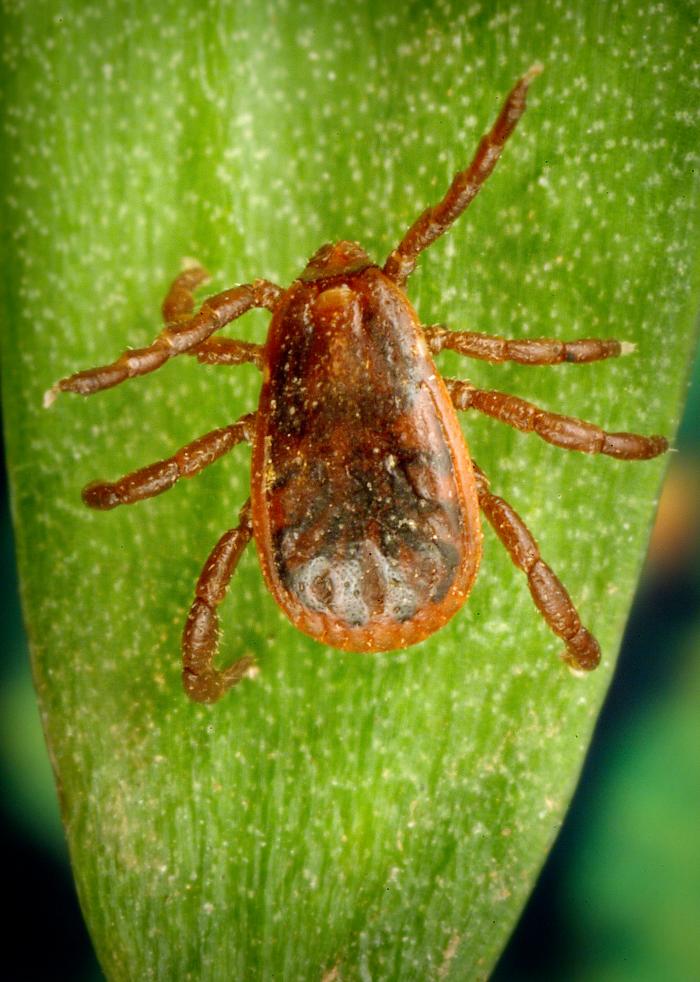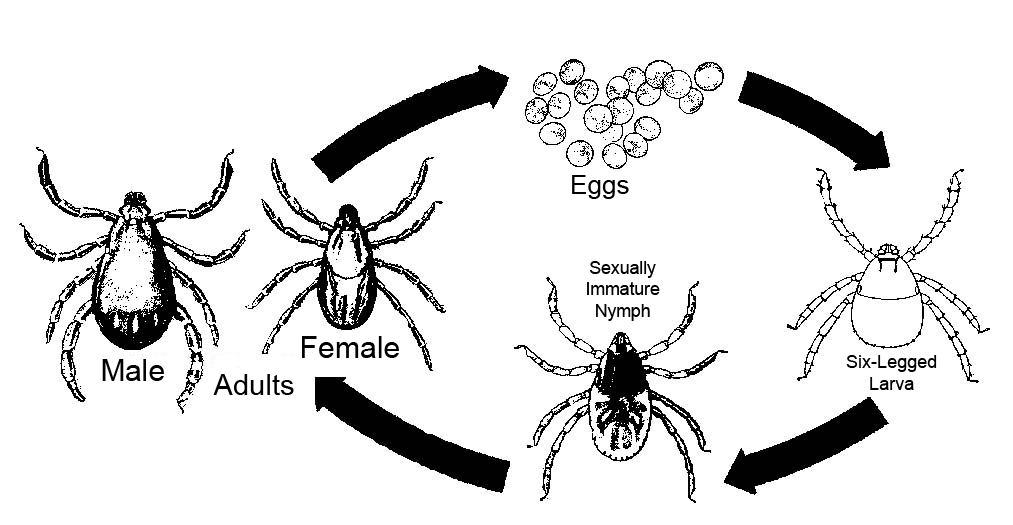Public Health
TICKS
Timothy J. Gibb, Extension Entomologist
Photo Credits: Jim Gathany, Center for Disease Control and Prevention
If you want to view as pdf, click here
Several species of ticks are found in Indiana. The most frequently encountered outdoor species is the American dog tick (also known as the eastern wood tick). The lone star tick and, more recently, the deer tick may also be found occasionally in outdoor, wooded areas. Another species, the brown dog tick, may sometimes become a problem indoors, primarily in association with dogs.
COMMON TICK SPECIES
American Dog Tick - Dermacentor variabilis
This tick is normally found in woods, uncut grassy fields, parks, and other areas of wild vegetation. Adults are dark brown or black, with short, rounded mouth parts and white markings on the dorsal side. In the spring and early summer, adult ticks are especially numerous along paths used by animals. Here they cling to bushes, tall weeds, etc., and attach themselves to animals that pass by.
Adult ticks will feed on a number of different animals (e.g., dogs, coyotes, cattle, horses, raccoons, humans). However, the larval and nymphal stages are usually found on small wild rodents. This is the main reason why this tick does not become established as a household pest.
The American dog tick is considered the most important vector of Rocky Mountain Spotted Fever (RMSF) in the United States. This tick can transmit the causal agent of RMSF through all of its life stages. Initial symptoms of this disease start from 3 to 10 days after a tick bite and often includes fever, chills, headache, and muscle aches. A rash usually appears 1 to 3 days after the onset of the fever, usually on the wrists and ankles and eventually spreading to the rest of the body. Treatment with broad spectrum antibiotics, when given early, will usually cure the illness. The earlier the disease is diagnosed and treatment started, the better are the results.
American dog tick.
Lone Star Tick - Amblyomma american
This tick is also commonly found in moist, wooded areas, especially in areas with established deer populations. Adults have long mouth parts. The adult female has a distinct single white spot on its back. This tick is extremely aggressive and nonspecific in its feeding habits, with all active life stages (larvae, nymphs, adults) feeding on a wide variety of mammals (including humans) and ground-feeding birds. Adults and nymphs are generally active from early spring through midsummer, with larvae (often called “seed ticks”) being active from late summer into early fall. In Indiana, these ticks are more frequently found in wooded areas in the southern half of the state. These ticks are suspected in the transmission of tularemia, RMSF and Lyme disease, but they are not considered important vectors of these diseases.
Lone star tick.
Deer Tick - Black-Legged (Ixodes scapularis)
The deer tick is a cause of concern because it serves as the primary vector of Lyme disease. Deer ticks are found in similar habitats as the American dog tick and lone star tick. Adults are small and dark brown in color, with no white markings on their dorsal side. Larvae and nymphs feed on a wide variety of small mammals (especially rodents - e.g., white-footed mouse), birds, deer, dogs, and humans. Adult deer ticks are largely dependent upon white-tailed deer for reproduction.
Lyme disease, caused by a spirochete the deer tick carries, has spread from the Northeast, where it was first discovered in 1975, through 43 states. Lyme disease today is most prevalent in the Northeast and Upper Midwest, including Indiana.
Early symptoms of Lyme disease can be mild and overlooked. Flu-like symptoms, chills, fever, and fatigue are often experienced. A first unique symptom is a red, expanding rash. More than one rash may appear, and they do not always occur at the site of the tick bite. The rash may occur anywhere on the body, even in inconspicuous places such as the armpit, groin, or back of the knee. The more severe symptoms may appear weeks, months, or even years after a tick bite. These may include severe headaches, arthritis, and nervous system or cardiac abnormalities. It is obviously much better for Lyme disease to be diagnosed and treated early. Lyme disease vaccines are no longer available. For recommended treatment, a doctor should be consulted.
Black-legged tick.
Brown Dog Tick - Rhipicephallus sanguineus
This tick differs from the other ticks mentioned, primarily in its feeding habits. Although it may be found occasionally on other animals, the principal hosts for all active stages (larvae, nymphs, adults) are dogs. They are most often found in and around pet bedding areas. After feeding, these ticks drop off their host and conceal themselves in any available cracks and crevices. Because of their strong tendency to climb, they are often found behind cove moldings and window frames and in furniture.
Brown dog tick.
TICK DEVELOPMENT
Ticks develop through 4 stages. Eggs are deposited in grassy areas or woods. After hatching the small, 6-legged larvae usually find and feed on small hosts such as rodents, rabbits, and squirrels.
After initial feeding, larvae molt into 8-legged nymphs which are approximately 2/3 the size of adults. Nymphs and adults usually seek out and feed on larger hosts such as deer, dogs, and people.
Life cycle of the tick.
TICK CONTROL AND PREVENTION
Personal Protection
For preventing outdoor tick exposure, avoid tick-infested areas, and wear protective clothing. Stay on established trails, and avoid brushing against vegetation. Wear light-colored clothing, long pants, and long-sleeved shirts so that ticks can be more easily seen. Tuck in your shirt, and pull your socks over the pant cuffs.
Apply an insect repellent to your shoes, socks, and pants. Effective tick repellents are those containing diethyl toluamide (DEET) or permethrin. Occasionally check yourself and your children for ticks, especially on the head, groin, and underarm area. Showering after coming indoors may help remove ticks that have not yet attached to the skin. Inspect pets after they have been outdoors, and remove ticks found.
If a tick is found attached on your skin, use the following procedure:
- Use blunt forceps or tweezers.
- Grasp the tick as close to the skin surface as possible and pull upward with a steady, even pressure.
- Take care not to squeeze, crush, or puncture the tick.
- Do not handle the tick with bare hands because infectious agents may enter via mucous membranes or breaks in the skin.
- After removing the tick, disinfect the bite site and wash hands thoroughly with soap and water.
- Consult a physician immediately if a rash or flu-like symptoms develop.
Outdoor Control Measures
Outdoor control is aimed primarily at the American dog tick, lone star tick, and deer tick. Manage outdoor areas to be unattractive for small mammals (mice, rats, racoons, squirrels, chipmonks, etc.) by removing nesting sites and clutter. Keep overgrown and heavy vegetation cleared and cut in tick-infested areas. Eliminate unnecessary vegetation around yards or property, along wood edges, or along the edges of trails and paths. Residual insecticides can be applied on infested areas such as along roads, walks, and trails where ticks congregate. Also, treatment can be made near ground level on grass and under shrubbery and trees, and along edges of wooded areas. Follow all label directions and precautions carefully before using any insecticides. When using spray formulations, keep children and pets off treated areas until dry. Some residual insecticides are available for use by professional pest control applicators only.
Indoor Control Measures
Indoor control is aimed primarily at the brown dog tick. It is difficult to control because of its many possible hiding places. Because tick eggs may hatch over a period of up to 5 months, more than one treatment may be necessary to eliminate the problem completely. Available spray insecticides for indoor treatment include: pyrethrins and carbaryl (Sevin®). Carbaryl is also available as a dust. Apply treatments around sleeping quarters of household pets, around baseboards, window and door frames, wall cracks, local areas of floors, floor coverings, and similar places where ticks might conceal themselves. Do not spray animal quarters directly. These can be treated with carbaryl (Sevin®) dust. Replace bedding in animal quarters after treating. Some insecticides are available for use by professional pest control applicators only. They include bendiocarb (Ficam-W®), propetamphos (Safrotin®), cyfluthrin (Tempo®), deltamethrin (Suspend®), and lambda-cyhalothrin (Demand®).
Control in Dog Kennels and on Dogs
Pyrethrins and malathion can be used as spray treatments in dog kennels and carbaryl (Sevin®) can be applied as a dust. Treat outside dog runways, window sills, and ledges. Do not contaminate food or water.
Carefully clean and then treat infested pets with an insecticidal dip or dust. Check with a veterinarian for available dips and other treatments. Insecticide-impregnated collars are available and can provide at least partial protection against tick infestation.
READ AND FOLLOW ALL LABEL INSTRUCTIONS. THIS INCLUDES DIRECTIONS FOR USE, PRECAUTIONARY STATEMENTS (HAZARDS TO HUMANS, DOMESTIC ANIMALS, AND ENDANGERED SPECIES), ENVIRONMENTAL HAZARDS, RATES OF APPLICATION, NUMBER OF APPLICATIONS, REENTRY INTERVALS, HARVEST RESTRICTIONS, STORAGE AND DISPOSAL, AND ANY SPECIFIC WARNINGS AND/OR PRECAUTIONS FOR SAFE HANDLING OF THE PESTICIDE.
December 2016

It is the policy of the Purdue University Cooperative Extension Service that all persons have equal opportunity and access to its educational programs, services, activities, and facilities without regard to race, religion, color, sex, age, national origin or ancestry, marital status, parental status, sexual orientation, disability or status as a veteran. Purdue University is an Affirmative Action institution. This material may be available in alternative formats.
This work is supported in part by Extension Implementation Grant 2017-70006-27140/ IND011460G4-1013877 from the USDA National Institute of Food and Agriculture.
1-888-EXT-INFO
www.extension.purdue.edu
Order or download materials from www.the-education-store.com







